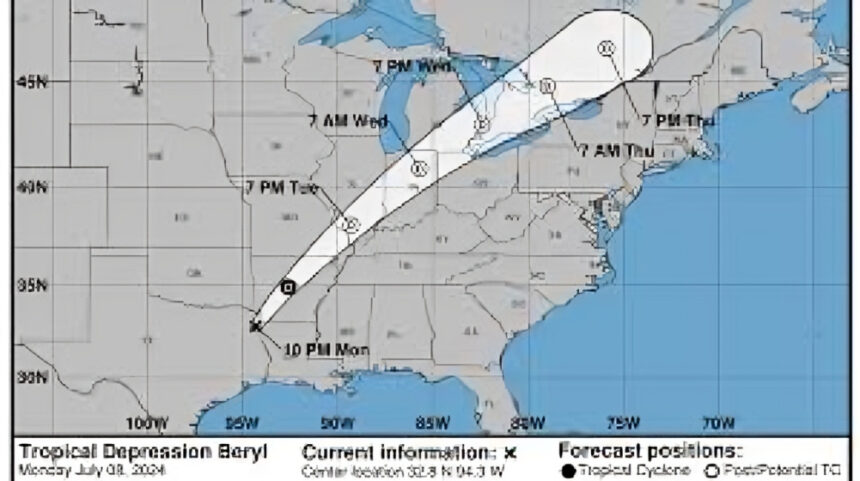Introduction
As nature’s forces shape our planet, we often find ourselves monitoring weather events like hurricanes, storms, and cyclones. One such phenomenon gaining attention is Beryl—a tropical storm that has captured the interest of meteorologists and residents in its projected path. In this article, we’ll delve into the Beryl projected path, its potential impact, and what you should know to stay prepared.
What is the Beryl Storm?
Before diving into the projected path, let’s understand what Beryl is. Beryl is a tropical storm that forms in the Atlantic Ocean. Like other tropical storms, it gains strength from warm ocean waters and can sometimes escalate into a hurricane. Although not all tropical storms become hurricanes, their impact can still be significant, with heavy rainfall, strong winds, and dangerous storm surges.
The Projected Path of Beryl: An Overview
Meteorologists use advanced technology, including satellite data and computer models, to predict the path of storms like Beryl. The Beryl projected path is subject to change as the storm develops, but certain trends and forecasts provide valuable insight for areas at risk.
Why Does the Projected Path Matter?
The Beryl projected path is crucial for several reasons:
- Early Warning Systems: Communities in the storm’s path can prepare for potential evacuations and safety measures.
- Impact Assessment: The path allows meteorologists to predict where the most severe weather will occur, such as heavy rains, strong winds, and possible flooding.
- Disaster Preparedness: Knowing where the storm is heading helps governments and emergency services plan responses effectively.
Key Factors Affecting the Projected Path
- Wind Patterns: Winds play a critical role in steering tropical storms. Changes in wind direction or strength can cause shifts in the projected path.
- Sea Surface Temperatures: Warm water fuels the storm, making it stronger. If Beryl encounters colder waters, its strength might diminish, altering its path.
- High and Low-Pressure Systems: These systems can either steer or deflect storms, impacting the storm’s trajectory.
Potential Impacts of Beryl
The Beryl projected path could potentially affect a wide region depending on its trajectory. Below are some common effects to expect in storm-prone areas:
1. Heavy Rainfall
Beryl’s intense rains can lead to flash floods, especially in coastal regions. Areas in the direct path of the storm might experience several inches of rain within a short period, which could overwhelm drainage systems.
2. Strong Winds
Winds associated with tropical storms like Beryl can be quite powerful, causing tree damage, power outages, and potential structural damage to homes and buildings.
3. Storm Surges
For coastal communities, storm surges are a significant concern. The rising sea levels due to the storm can inundate low-lying areas, creating hazardous conditions.
4. Tornadoes
Although less frequent, tropical storms like Beryl sometimes spawn tornadoes. These tornadoes can cause localized but intense damage.
How to Prepare for Beryl’s Projected Path
Regardless of whether Beryl intensifies or weakens, preparing for any potential storm is crucial. Here are a few steps to ensure you and your loved ones are safe:
- Stay Informed: Regularly check weather updates and official warnings to track the storm’s path. Apps, news stations, and weather websites are excellent sources.
- Create an Emergency Plan: Plan for evacuation routes, emergency contacts, and necessary supplies like food, water, and medications.
- Prepare Your Home: Secure windows, doors, and outdoor furniture. If you live in a flood-prone area, elevate items to higher ground.
Conclusion
The Beryl projected path provides valuable information to help communities prepare for the storm’s possible impact. While forecasts can change, staying informed and taking proactive steps is the best way to safeguard yourself and your family. Keep an eye on the storm’s developments, and always follow local authorities’ advice for the most accurate guidance.
FAQs
What is the Beryl projected path?
The Beryl projected path refers to the predicted trajectory of the tropical storm, including where it will travel and which regions it may impact.
Can the Beryl projected path change?
Yes, the path of a tropical storm can change due to shifting weather conditions, such as wind patterns and pressure systems.
How accurate is the Beryl projected path?
While meteorologists use advanced technology to predict storm paths, there is always some degree of uncertainty, especially with storms like Beryl that may change rapidly.
What are the impacts of Beryl?
The potential impacts of Beryl include heavy rainfall, strong winds, storm surges, and possibly tornadoes, depending on its strength and trajectory.
How can I prepare for Beryl’s projected path?
Stay informed about the storm’s progress, create an emergency plan, and take steps to secure your home and possessions to minimize damage.







